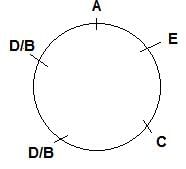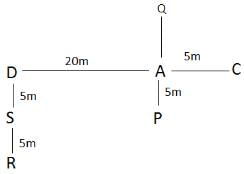This EduRev document offers 10 Multiple Choice Questions (MCQs) from the topic Data Sufficiency (Level - 1). These questions are of Level - 1 difficulty and will assist you in the preparation of CAT & other MBA exams. You can practice/attempt these CAT Multiple Choice Questions (MCQs) and check the explanations for a better understanding of the topic.
Question for Practice Questions Level 1: Data Sufficiency - 1
Try yourself:Directions: This problem consists of a question followed by two statements numbered I and II given below it. Read the statements carefully and decide which of them is/are sufficient/necessary to answer the question.
Mark your answer as
a. if the data in statement I alone is sufficient to answer the question, while the data in statement II alone is not sufficient to answer the question
b. if the data in statement II alone is sufficient to answer the question, while the data in statement I alone is not sufficient to answer the question
c. if the data in either of the statements alone is sufficient to answer the question
d. if the data in both statements I and II together is not sufficient to answer the question
e. if the data in both statements I and II together is necessary to answer the question
Q. Five people A, B, C, D and E sit around a circular table facing the centre. Who sits to the immediate right of D?
I. C sits second to the left of A, who sits adjacent to E.
II. No person sits between D and B.
Explanation
From I alone, we can figure out that A sits second to the right of C and E could be sitting to the immediate left or right of A.
Thus, we cannot determine the position of D. Hence, statement I alone is not sufficient.
From II alone, we only know about B and D. Thus, II alone is not sufficient.
From I and II together, we can figure out the arrangement like this:

Since we still cannot accurately determine the positions of D and B, statements I and II together are not sufficient to answer the question
Report a problem
Question for Practice Questions Level 1: Data Sufficiency - 1
Try yourself:Directions: This problem consists of a question followed by two statements numbered I and II given below it. Read the statements carefully and decide which of them is/are sufficient/necessary to answer the question.
Mark your answer as
a. if the data in statement I alone is sufficient to answer the question, while the data in statement II alone is not sufficient to answer the question
b. if the data in statement II alone is sufficient to answer the question, while the data in statement I alone is not sufficient to answer the question
c. if the data in either of the statements alone is sufficient to answer the question
d. if the data in both statements I and II together is not sufficient to answer the question
e. if the data in both statements I and II together is necessary to answer the question
Q. On which date did Amit celebrate his birthday in October if the year given is same?
I. Amit remembers that his birthday was on the last Monday of October.
II. Amit went to buy clothes on 15th October, which was a Sunday.
Explanation
I alone is not sufficient because we cannot decode the date. We need to know what day the month started on to get the date on final Monday of October.
II alone is not sufficient because it will only tell us about all the dates and days of October, but any of such day could be his birthday.
I and II together are required because from II, we know that on 15th, it was Sunday and in a week, there are 7 days. So, (15 - 7) = 8th October was Sunday and (8 - 7) = 1st October was a Sunday.
So, last day i.e. 31st October was a Tuesday. From I, we know that his birthday was on last Monday. i.e. 30th October was his birthday.
Report a problem
Question for Practice Questions Level 1: Data Sufficiency - 1
Try yourself:Directions: This problem consists of a question followed by two statements numbered I and II given below it. Read the statements carefully and decide which of them is/are sufficient/necessary to answer the question.
Q. Who among P, Q, R, S and T has the most number of sweets?
I. P has more sweets than both R and S.
II. Only one person has more sweets than P.
Explanation
From I only, we get that P has more sweets than both R and S, but we can't deduce that P has most number of sweets. Thus, option 1 isn't correct.
From II alone, we cannot find the answer because of inadequate information. Thus, option 2 isn't correct.
From I and II together, we get that P has more sweets than both R and S and only one person has more sweets than P, and that person could be either Q or T. So, no definite answer is possible.
Therefore, both statements together are insufficient.
Report a problem
Question for Practice Questions Level 1: Data Sufficiency - 1
Try yourself:Directions: This problem consists of a question followed by two statements numbered I and II given below it. Read the statements carefully and decide which of them is/are sufficient/necessary to answer the question.
Q. In which direction is point X with respect to point D?
I. Point X is to the west of point B, which is to the north of point C.
II. Point Z is to the north of point D and to the east of point B.
Explanation
Using both statements together, we get the following diagram:

Point X is to the northwest of Point D. Position of D will not make difference in the answer.
So, the data in both statements together is necessary to answer the question.
Report a problem
Question for Practice Questions Level 1: Data Sufficiency - 1
Try yourself:Directions: In this problem, a question is given followed by three statements numbered I, II and III. Read the statements carefully and decide which of them is/are sufficient/required to answer the question.
Q. How much did Ravi score in Computer Science?
I. The average score obtained by Ravi in 4 subjects, including Computer Science, was 65.
II. The score obtained by Ravi in Computer Science and English together was 190.
III. The score obtained by Ravi in English and Maths together was 170.
Explanation
From I: Total score in 4 subjects = (65 × 4) = 260
From II: Total score (Computer + English) = 190
From III: Total score (English + Maths) = 170
Thus, the data is insufficient to find the answer.
Report a problem
Question for Practice Questions Level 1: Data Sufficiency - 1
Try yourself:Directions: In this problem, a question is given followed by three statements numbered I, II and III. Read the statements carefully and decide which of them is/are sufficient/required to answer the question.
Q. A, B, C, D and E are five friends. Their mean age is 14. What is the age of C?
I. A's age is 14 years.
II. B's age is 3 years less than E's age, and E's age is 7 years less than D's age.
III. C's age is 7 years more than B's age and 5 years more than E's age.
Explanation
A + B + C + D + E = 70
From I, A = 14, B + C + D + E = 56
From II, B = E - 3 and E = D - 7
So, D = E + 7
From III, C = B + 7 and C = E + 5.
So, the age of every friend can be defined in terms of E's age. Hence, we can find the answer using all three statements together.
Report a problem
Question for Practice Questions Level 1: Data Sufficiency - 1
Try yourself:Directions: The following problem contains a question and three statements numbered I, II and III. Read the statements carefully and determine which of them is/are sufficient/required to answer the question.
Q. Who is younger between Deepak and Ankit?
I. Deepak is 5 years older than Manish, who is 3 years younger than Kapil.
II. Ankit is older than Kapil.
III. Balkishan is the oldest in the whole group.
Explanation
- Statements I and II show that Deepak is 2 years older than Kapil and Ankit is also older than Kapil.
- Hence, the ages of Deepak and Ankit cannot be compared.
- Statement III does not provide any clue either.
- Hence, option (4) is correct.
Report a problem
Question for Practice Questions Level 1: Data Sufficiency - 1
Try yourself:Directions: The following problem has a question and statements labelled I, II and III. You have to decide which of the following statements is/are sufficient to answer the question.
Q. Among football, hockey, chess and badminton, which sport does Balkishan play?
I. He plays at least two sports.
II. If the sports are written in an alphabetical order, then he does not play the sports at the extreme ends.
III. He plays exactly two sports.
Explanation
I and III alone do not give any information. Also, II shows that he does not play badminton and hockey, but that does not imply that he plays both the remaining sports. So, I or III combined with II is sufficient to answer the question.
Report a problem
Question for Practice Questions Level 1: Data Sufficiency - 1
Try yourself:Directions: In the following problem, a question followed by three statements (I), (II) and (III) is given. You have to determine which statement(s) is/are sufficient/necessary to answer the question.
Q. How far and in which direction is D with respect to Q?
I. R is 10 m to the South of D, who is 5 m to the North of S.
II. D is 20 m to the West of A, who is to the South of Q.
III. P is 5 m to the South of A, who is 5 m to the West of C, who is to the Southeast of Q.
Explanation
Even using all three statements, we cannot find the distance between D and Q.

Report a problem
Question for Practice Questions Level 1: Data Sufficiency - 1
Try yourself:Directions: In this problem, a question is given followed by three statements numbered I, II and III. Read the statements carefully and decide which of them is/are sufficient/required to answer the question.
Q. The second Friday of May 2015 fell on which date?
I. 29th was the last Friday of that month.
II. The last day of that month was a Sunday.
III. There were 5 Fridays in May-2015.
Explanation
From I, we can conclude that 29th, 22nd, 15th, 8th and 1st May were all Fridays.
Thus, 8th May, 2015 was the second Friday of the month.
From II, we can conclude that 31st May, 2015 was a Sunday.
Thus, 8th May, 2015 was the second Friday of the month.
Report a problem



















